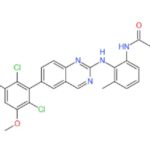BLU-9931
$50.00 – $350.00
BLU-9931 (CAS No.: 1538604-68-0), a potent, highly selective, and irreversible fibroblast growth factor receptor 4 (FGFR4) inhibitor with an IC50 of 3 nM and a Kd of 6 nM. BLU-9931 has significant antitumor activity. >98% Purity.
Synonyms: FGFR4 inhibitor, fibroblast growth factor receptor 4 inhibitor
For Research Use Only.
- Product Details
- Description
- Additional information
- More Offers
Description
APIM050414: BLU-9931 is a potent, highly selective, and irreversible fibroblast growth factor receptor 4 (FGFR4) inhibitor with an IC50 of 3 nM and a Kd of 6 nM. BLU-9931 has significant antitumor activity.
CAS No.: 1538604-68-0
IUPAC/Chemical Name: (N-(2-((6-(2,6-dichloro-3,5-dimethoxyphenyl)quinazolin-2-yl)amino)-3-methylphenyl)acrylamide
Molecular Formula: C26H22Cl2N4O3
Molecular Weight: 509.38
Purity: >98% Purity
QC: Achiral and Chiral HPLCs, MS, NMR, and Quantitative Elemental Analysis Report
Solubility: Soluble in DMSO
Storage: Dry, dark and at 0 – 4 C for short term (days to weeks) or -20 C for long term (months to years).
Note: Please contact us for COA, Spectra, and SDS information.
Background Information:
BLU-9931 (CAS No. 1538604-68-0), a quinazoline derivative, was the first reported FGFR4 selective inhibitor. X-ray crystal structure of FGFR4 and BLU-9931 revealed that the aminoquinazoline core formed two hydrogen bonds with the hinge region amino acid residue Ala553 and the acrylamide bond with Cys552 covalently to achieve potent FGFR4 activity and the desired selectivity over FGFR1/2/3. Despite great potency and specificity, BLU9931 does not enter clinical studies, presumably due to its rapid metabolism in liver microsomes. Predictive computational modeling, together with experimental studies, identified BLU9931’s potential metabolic sites. [1]
Target: FGFR1, FGFR2, FGFR3, FGFR4
IC50: 594 nM (FGFR1), 493 nM (FGFR2), 150 nM (FGFR3), 3 nM (FGFR4)
In Vitro: BLU-9931 (CAS No. 1538604-68-0) inhibits proliferation of HCC cell lines that express an intact FGFR4 signaling complex, with EC50s of 0.07 μM, 0.11 μM and 0.02 μM for Hep 3B, HuH7 and JHH7 cells, respectively. [2]
BLU-9931 (0.3-300 nM; 1 hour; MDA-MB-453 and Hep 3B cells) treatment demonstrates potent, dose-dependent reduction of phosphorylation of FGFR4 signaling pathway components, including fibroblast growth factor receptor substrate 2 (FRS2), MAPK, and AKT in MDA-MB-453 cells. BLU-9931 shows dose-dependent inhibition of the signaling cascade downstream of FGFR4. BLU-9931 exhibits potent inhibition of phosphorylation of the FGFR4 pathway components in Hep 3B cells. BLU9931 treatment leads to induction of caspase-3/7 activity, indicative of induction of apoptosis that results in inhibition of signaling downstream of FGFR4. [2]
BLU-9931 (100 nM; 0 -24 hours; Hep 3B cells) treatment increases CYP7A1 mRNA expression and the expression of the proliferative marker EGR1 is inhibited. [2]
In Vivo: BLU-9931 (10-100 mg/kg; oral administration; twice every day; for 21 days; mice) treatment demonstrates antitumor activity in HCC xenograft models. [2]
What is the solubility of BLU-9931 in vitro?
DMSO: > 125 mg/mL
What is the solubility of BLU-9931 in vivo?
1. DMSO, PEG300, Tween-80, and saline
Please add 10% DMSO, 40% PEG300, 5% Tween-80, and 45% saline in order, solubility: ≥ 2.08 mg/mL.
2. DMSO and 20% SBE-β-CD in saline
Please add 10% DMSO and 90% (20% SBE-β-CD in saline) in order, solubility: ≥ 2.08 mg/mL.
3. DMSO and corn oil
Please add 10% DMSO and 90% corn oil in order, solubility: ≥ 2.08 mg/mL.
Reference:
[1]. Pan, C. et al. “Design, synthesis and biological evaluation of quinazoline derivatives as potent and selective FGFR4 inhibitors”, Eur. J. Med. Chem., 2021, 225, 113794
[2]. Hagel, M. et al. “First Selective Small Molecule Inhibitor of FGFR4 for the Treatment of Hepatocellular Carcinomas with an Activated FGFR4 Signaling Pathway”, Cancer Discov., 2015, 5, 424-437
[3]. Sasaki, N. et al. “FGFR4 Inhibitor BLU9931 Attenuates Pancreatic Cancer Cell Proliferation and Invasion While Inducing Senescence: Evidence for Senolytic Therapy Potential in Pancreatic Cancer”, Cancers (Basel), 2020, 12, 2976.
[4]. Kanzaki, H. et al. “The impact of FGF19/FGFR4 signaling inhibition in antitumor activity of multi-kinase inhibitors in hepatocellular carcinoma”, Sci. Rep., 2021, 11, 5303
Frequent questions related to “BLU-9931 (CAS No. 1538604-68-0), a highly selective and irreversible fibroblast growth factor receptor 4 (FGFR4) inhibitor”:
Does BLU-9931 bind mouse FGFR?
Who makes BLU-9931?
What is BLU-9931?
What is the mechanism of action for BLU-9931?
Popular searches related to “BLU-9931 (CAS No. 1538604-68-0), a highly selective and irreversible fibroblast growth factor receptor 4 (FGFR4) inhibitor”:
BLU-9931 results
BLU-9931 fda approval
BLU-9931 mechanism of action
BLU-9931 price
BLU-9931 synthesis
BLU-9931 analogue
BLU-9931 structure activity study
BLU-9931 in vitro
BLU-9931 in vivo
BLU-9931 supplier
BLU-9931 clinical study
BLU-9931 Cytotoxicity
BLU-9931 Target
fibroblast growth factor receptor 4
BLU-9931 EGFR4 inhibitor
BLU-9931 purchase
BLU-9931 fibroblast growth factor receptor 4 inhibitor
Additional information
| Size | 10 mg, 100 mg, 5 mg, 50 mg |
|---|





